

A Quick Start Guide to UX Design. Key UX Strategy Methods, Tools, and Deliverables. By Janet M.
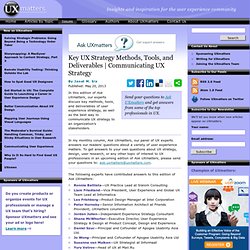
Six Published: May 20, 2013. 10 Principles of Lean User Experience. Applying Lean UX. We recently wrapped up a project for a startup in the digital photography space, and aside from being great design partners, one of the fun things about them was their excitement to utilize some of the Lean UX strategies and techniques that former Cooperista Josh Seiden wrote about in his bookLean UX with Jeff Gothelf.
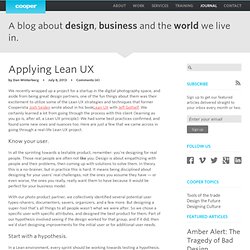
We certainly learned a lot from going through the process with this client (learning as you go is, after all, a Lean UX principle). We had some best practices confirmed, and found some new ones and nuances too. Organizational Culture 101: A Practical How-To For Interaction Designers. Organizations are tenuous phenomena; they can fall apart at any time.
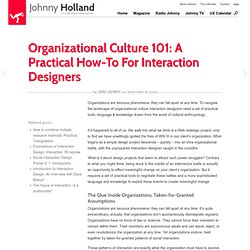
To navigate the landscape of organizational culture interaction designers need a set of practical tools, language & knowledge drawn from the world of cultural anthropology. It’s happened to all of us. We walk into what we think is a Web redesign project, only to find we have unwittingly ignited the fires of WW III in our client’s organization. What begins as a simple design project descends – quickly – into an intra-organizational battle, with the unprepared interaction designer caught in the crossfire. What is it about design projects that seem to attract such power struggles?
The Glue Inside Organizations: Taken-for-Granted Assumptions Organizations are tenuous phenomena; they can fall apart at any time. Interaction Design for Specialized Tasks. No single user is “special” – or maybe all users are?

Either way you look at it, we as interaction designers will encounter contexts of use or knowledge domains out of the ordinary at some point or other during our career. In my experience, designers need not apply magic tools when designing for special situations. It is however beneficial to bear in mind some core differences between specialized use contexts and the mainstream use of a mass consumer product such as a social networking site or a mobile phone. And that’s what I want to focus on in this article. In the digital work environment of a specialist such as the nurse, designing the patient vital sign monitor requires the interaction designer to use and apply domain-specific knowledge. So how can we design the best possible systems when faced with these special contexts? Observations on Designers. It’s been a long time since I’ve written anything for Johnny, which I apologize for.

I’ll keep this as a short observation piece on what I’ve seen in the last several years and what I’d like to see moving forward. I’m Interested in any comments others might have. Stereotypes Sometime ago, I watched a video of a Microsoft developer conference where one of the speakers was discussing the Expression Blend applications; tools to help the designer/developer workflow. When it was time, the presenter turned around, put on a beret, turned back around, and pretended to be a designer.
Emerging a User Experience Strategy. In our previous article, we focused on the first step to developing a User Experience (UX) strategy by presenting how user stories are generated, themed and prioritised, as a means of helping us to understand the shape of the project (what) and its purpose (why).

In this article we focus on the use of scenarios and paper prototypes to support a rapid and collaborative exploration of potential implementation approaches (how). An Approach to UX Strategy The goal of the strategy phase is to ensure that all stakeholders are similarly focused and aligned around project goals, i.e there is agreement in principle about the purpose of the project and the priorities for implementation. A high level agreement to what the project is, why we are doing it, and how it will be achieved reduces the risk of budget blow outs or conflicts in the design phase by ensuring that all project stakeholders have similar expectations. Critiquing UX. This post comes from Rebecca Albrand at the Infragistics blog.
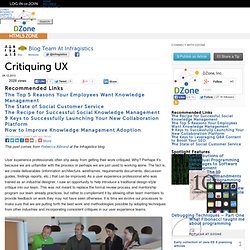
User experience professionals often shy away from getting their work critiqued. Why? Perhaps it's because we are unfamiliar with the process or perhaps we are just used to working alone. The fact is, we create deliverables (information architecture, wireframes, requirements documents, discussion guides, findings reports, etc.) that can be improved. Web Development Project Estimator.
Work, Play, and Code. The End of Fun - Lone Star Ruby. RubyConf Keynote - No Notes - Full Builds. Design Minded Development, Do.com's Austin Bales at Heroku's Waza 2013. Ask and Ask Again: Critical Interviewing Is an Essential Component of Usability Testing. By Kate Lawrence Published: November 1, 2012 “Your role as a usability test facilitator … should be to facilitate according to your understanding of test participants.
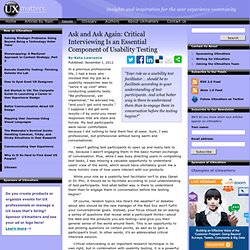
And what better way is there to understand them than to engage them in conversation before the testing begins?” In a previous professional life, I had a boss who insisted that my job as a usability researcher was to “serve it up cold” when conducting usability tests. “Be professional, yet impersonal,” he advised me, “and you’ll get solid results.” I wasn’t getting test participants to open up and really talk to me, because I wasn’t engaging them in the basic human exchange of conversation. While your role as a usability test facilitator isn’t to play Oprah or Dr. Of course, random topics like How’s the weather? Make Users Feel Comfortable Play the gracious host or hostess.
The Importance of Knowing User Intent. By Jordan Julien Published: October 22, 2012 “There is subtle, but important barrier to applying empathy to design that lies in our perception of the user.”
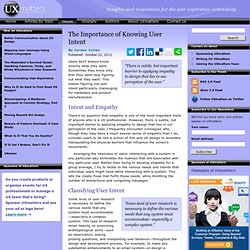
Users don’t always know exactly what they want. Sometimes they know only that they want help figuring out what they want. This makes figuring out user intent particularly challenging for marketers and product manufacturers. Intent and Empathy. Using Verbs As Nouns in User Interfaces. By Janet M.
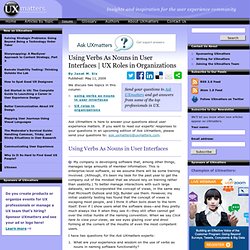
Six Published: May 11, 2009. Expressing UX Concepts Visually. By Barnabas Nagy Published: May 7, 2012 “Words are not always sufficient to describe things accurately.” It is all too easy to create UX deliverables that are not visually pleasing. Practicing Great UX Consulting: Part 1. By Baruch Sachs Published: June 3, 2013. Becoming a Great UX Consultant, Part 1: Some Myths.
Becoming a Great UX Consultant, Part 2: Some Advice. By Baruch Sachs Published: April 1, 2013. Great User Experiences Require Great Front-End Development. By Jim Nieters, Amit Pande, and Uday M. Shankar Published: April 24, 2012 With this article, we’re introducing our new column—Breakthrough Application Design—Designing game-changing experiences. In this column, we’ll discuss innovative approaches to application design that are based on our personal experience in the trenches. Fast, Loose, and Oh-So-Very Wrong: How I’ve Come to Love Agile UX Design. Bootstrapping UX: A Case Study. By Simon White. The Five Competencies of User Experience Design. By Steve Psomas.